
Facebook Twitter Instagram YouTube RSS Feed
Written on: May 13th, 2020 in Outreach

Guest writer: Maggie Pletta, DNREC Division of Climate, Coastal & Energy
Delaware is known for its ability to tackle complex problems by bringing its residents together to work out solutions. Among this year’s problems: planning how the state will respond to climate change.
The impacts of climate change vary around the globe, but in Delaware, the changes we are already experiencing include increased temperatures and rising sea levels. These impacts are expected to continue or worsen. Moreover, climate scientists anticipate precipitation patterns will also change, with more frequent intense storms hitting the state. These changes will have major impacts on human health and safety, our natural resources (like wetlands), agriculture, and transportation infrastructure.
The annual average temperature in Delaware has risen 2 degrees since 1900, and the best available science projects that by 2050, the average temperature in the state will be between 2.5 and 4.5 degrees warmer than it is today. Increased temperatures directly threaten human health in a variety of ways including heat rash, heat cramps, heat exhaustion, and heat stroke. All can aggravate underlying health conditions and cause the heart, kidneys, lungs, and other internal organs to fail. But human health is not the only thing impacted by high temperature; roadways can also heave and buckle during heat waves, damaging critical infrastructure.
Records at the Lewes tide gauge indicate that sea level has risen more than a foot over the last century and are projected to rise an additional 9 to 23 inches by 2050. As sea level continues to increase a variety of impacts occur, most notably flood damage to habitats, roads, and infrastructures located in low-lying areas. Other impacts include increased erosion rates and saltwater intrusion in coastal soil and water resources that can render them unusable for agriculture and drinking water.
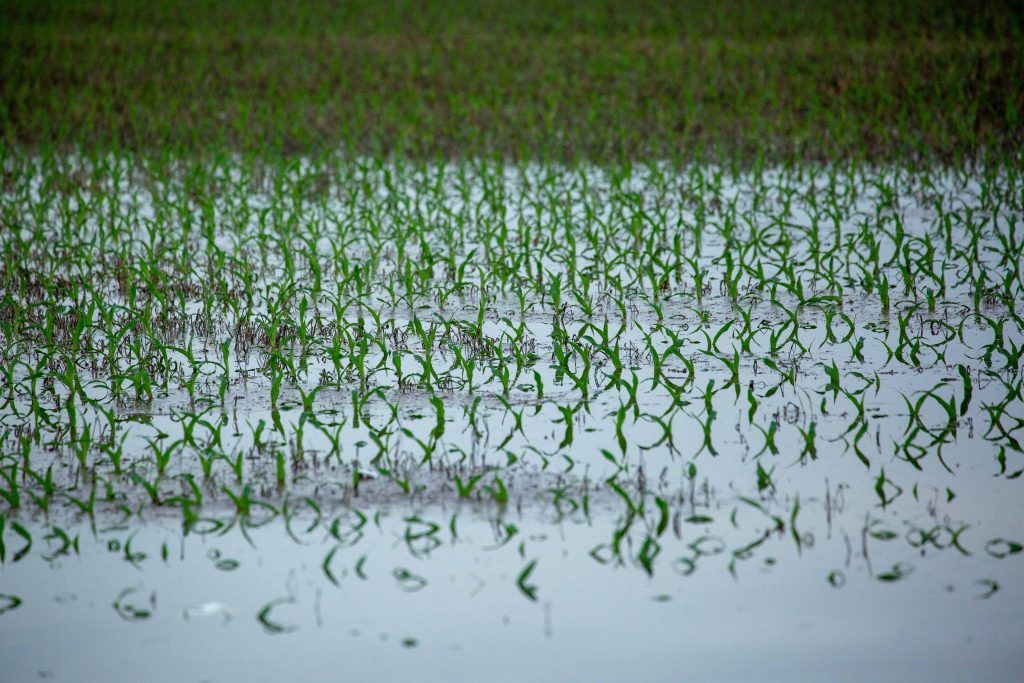
While the most recent climate trends do not show an increase in precipitation and extreme weather events, it is projected there will be noticeable changes in the future. It is projected there will be a 5% increase in average yearly precipitation and increased frequency and intensity of extreme weather events by 2050 and a 10% increase in precipitation amounts by century’s end. Changes in precipitation, including extreme rainfall events, will affect agriculture by damaging crops, altering growing seasons, and increasing crop disease pressure.
Over the course of 2020, the state is working to create the Delaware’s Climate Action Plan, a framework for how Delaware can address the causes and consequences of climate change in the decades ahead. The plan will build on years of research, plans, and commitments, such as the state’s sea level rise planning process and Delaware’s participation in the Regional Greenhouse Gas Initiative and the U.S. Climate Alliance.
The plan will map out actions to reduce greenhouse gas emissions from various economic sectors, including transportation, industry, and energy production — the three leading greenhouse gas emitters in the state.
Additionally, the plan will lay out the actions state agencies can take to support the state in adapting to climate change. These actions will be shaped by the best adaptation practices from across the world.

In developing Delaware’s Climate Action Plan, DNREC’s Division of Climate, Coastal & Energy (DCCE) hosted three public workshops in early March to learn of Delawareans’ experience with climate impacts and to gather input on how the state can best address the causes and consequences of climate change. More than 250 people attended the workshops.
The Division also held a technical advisory workshop in March with representatives from the transportation, buildings, energy, and industrial sectors to solicit ideas for reducing greenhouse gas emissions. Summary reports for the public and technical advisory workshops will be posted in the coming weeks on declimateplan.org.
DCCE’s Climate Action Plan team is continuing to shape the plan during these unprecedented times, working with technical consultants to put together a comprehensive greenhouse gas analysis that will examine which statewide strategies may be most effective in reducing the state’s carbon footprint.
The Climate Action Plan team is also actively engaging with stakeholders from across DNREC and other state agencies to identify possible adaptation actions these agencies can take as part of the final plan. These ideas for adaptation actions will be presented to the public later this year for feedback. Details on how to provide feedback will be posted online at declimateplan.org, on our Facebook and Twitter, and via the DCCE Newsletter.
For the plan to be successful, we need to hear from you, on what actions you want the state to take to address climate change.
You can provide feedback and your input in a variety of ways:
Also, be sure to follow our project website at declimateplan.org or our Facebook and Twitter pages for the most up-to-date information. With your feedback and support, we aim to create a plan that shapes a future where individuals, businesses, communities, and institutions can deal with extreme weather, harness clean energy, breathe fresh air, and live healthier lives.
Written on: May 13th, 2020 in Living Shorelines, Outreach, Wetland Restorations
Guest writer Andrew Bell, DNREC Shellfish & Recreational Water Program
At first glance, an oyster appears to be little more than, well, a bit of goo inside a rock. But actually, the humble oyster is an environmental warrior with an impressive bag of tricks up its sleeve, and it serves as a keystone species upon which depends the health of a marine ecosystem and the surrounding marsh.
Oysters provide numerous essential ecosystem services to waterbodies and wetlands.
Let’s learn more about each of these three environmental services provided by the amazing oyster.
The most obvious of the oyster’s multiple roles in Mother Nature’s army is as a water filter. Oysters eat by pumping the surrounding water through their bodies, removing from the water bits of food along with harmful excess sediments and nutrients. A single oyster can filter up to fifty gallons of water per day. Multiply that by many millions of oysters throughout an entire waterbody, and you’ve got a contaminant-gobbling army capable of filtering an entire estuary every couple days!
This filter feeding results in clearer waters which let in more sunlight, and meanwhile the depositing of oyster feces establishes a nutrient-rich seabed. This combination allows threatened seagrasses to establish beds, in turn providing habitat for marine animals such as crabs and clams. In this way, oyster reefs ultimately support the entire marine food chain.
Further, the sequestration by oysters of excess nitrogen and other nutrients prevents harmful algal blooms, which can rapidly consume all oxygen in the water and cause mass die-offs of fish and other aquatic life. Helping with this are certain bacteria that grow in the material produced by the deposition of oyster feces, which convert nitrogen into a form unusable by the algae.
Oysters are built to clean the water, and they do so at significantly lower costs than other cleanup technologies. Unfortunately, across the East Coast, the loss of oyster populations has transformed waterbodies from clear and healthy to murky and anoxic – more on that later.
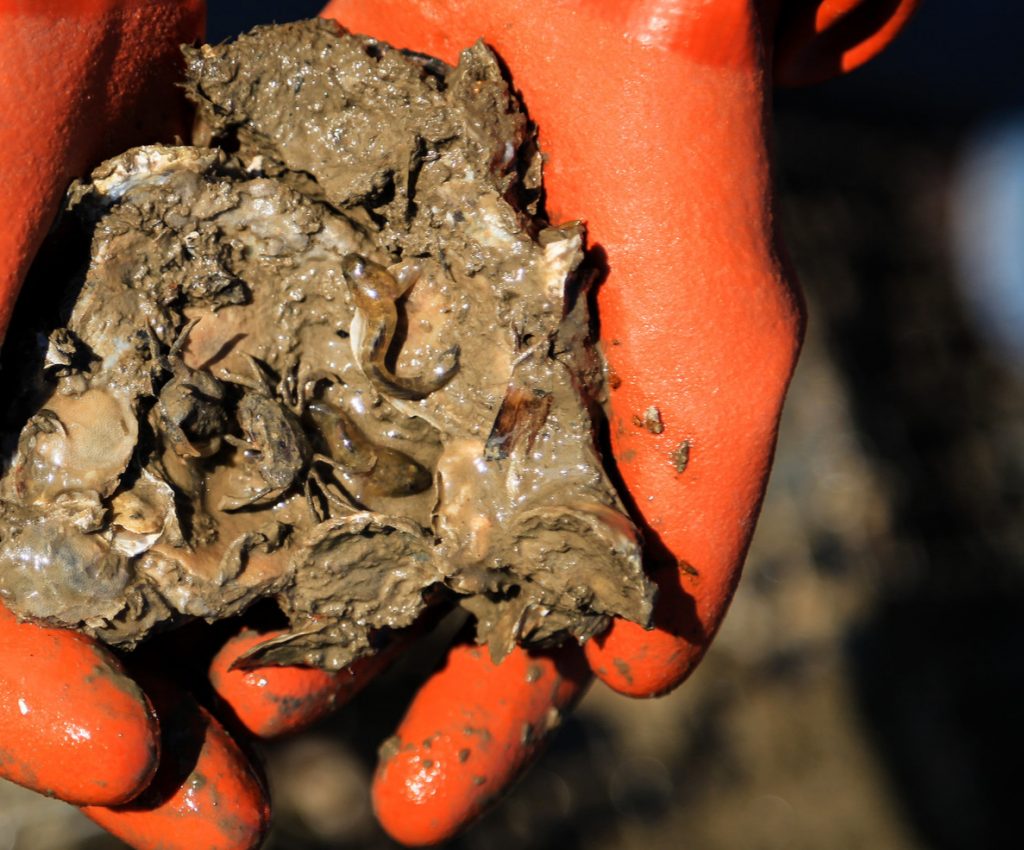
Oysters begin life as microscopic larvae that swim freely in the water before settling down on a hard surface such as rock or older shells. Now known as spat, the oysters grow into adults and fuse together into large reefs consisting of thousands of individuals. The complex three-dimensional reef structures provide essential habitat for a vast range of marine flora and fauna.
Species like mussels, barnacles, and sea anemones settle on reefs, establishing abundant food sources for fish species important to recreational and commercial harvest. Species like oyster gobies and blennies lay their eggs inside dead oyster shells to conceal them from predators. Most importantly, the innumerable nooks and crannies in an oyster reef provide shelter for marine critters, which is especially essential for juveniles in need of hiding places.
Life is not easy for baby fish and invertebrates, but oyster reefs help by buffering temperature extremes and by providing shelter from hungry predators. The presence of these organisms then attracts larger predators which in turn attract even larger predators, and in this way an oyster reef establishes its own complex and self-sustaining ecosystem. For aquatic critters, an oyster reef can be like an oasis in the middle of a desert.
Also among the many environmental benefits of the oyster is its effectiveness as a natural breakwater – in fact, it is more effective than artificial methods. Whereas artificial breakwaters like solid seawalls only deflect wave energy, potentially just passing the problem down the coast, oyster reefs dissipate the wave energy. And unlike artificial methods, an oyster reef grows and changes naturally, allowing it to keep pace with sea level rise.
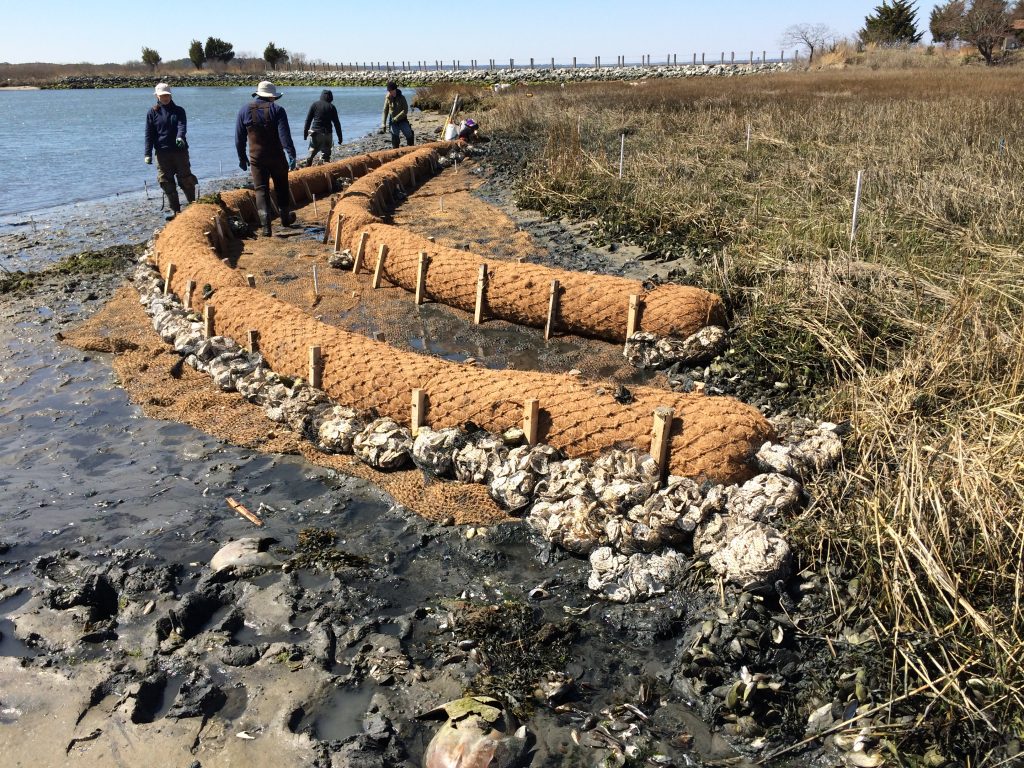
The effectiveness of a reef depends on many factors including its size and orientation, but under ideal conditions, an oyster reef will reduce up to 90% of wave energy. Oyster reefs can be especially valuable as natural breakwaters in areas where high boat traffic intensifies shoreline erosion.
The resulting calmer waters support the growth of coastal marshes and seagrass beds, which can then begin providing their own services to the ecosystem. This leads to a highly beneficial form of natural coastal and wetland protection, wherein multiple habitat types work together to maximize the benefits to the humans and animals that rely upon the coastal environment.
Oyster reefs are so essential to shoreline and wetland protection that empty shells are collected from restaurants and individuals by the Delaware Center for the Inland Bays and the Partnership for the Delaware Estuary. These organizations then stuff the shells into mesh bags that are placed along the edge of living shorelines projects. The resulting line of recycled shells then serves as the first line of defense for protecting the marsh edge from erosion by waves, and also as substrate on which new oyster reefs may form.
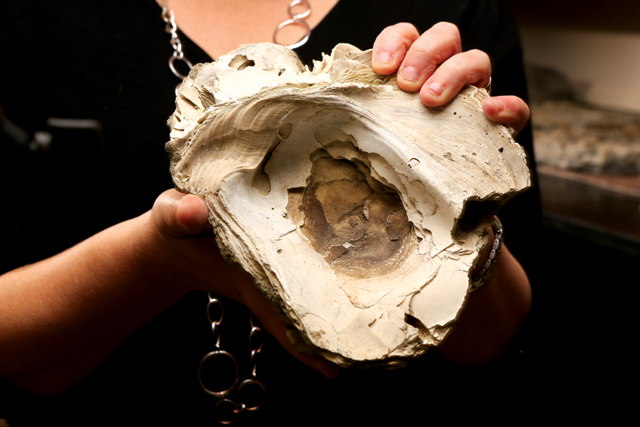
In the early 1600s, when Captain John Smith explored our region, he wrote that the oyster reefs were so numerous that the ship had to carefully navigate around them. Unfortunately, today oyster levels are at historic lows in the Delaware region and in other areas along the US coasts. By the mid-20th century, a conspiration of overharvesting, oyster diseases, and habitat degradation had devastated oyster populations, which have been having trouble recovering ever since.
Today, oyster populations are showing some hopeful signs, but the news remains mixed. As a keystone species, the devastation of oysters has resulted in waters that are murkier and more frequently anoxic, loss of important habitat, and erosion of shorelines and marsh.
Fortunately, just as the loss of oysters results in great harm to other species, the reintroduction of oysters can help those species recover. Oyster restoration is a top priority of many environmental organizations because the ecosystem services provided by oysters are so significant, varied, and long-lasting. Not to mention, oyster restoration efforts are often more cost-effective and technologically simpler than other types of projects.
Last year, the first oysters grown in the Inland Bay’s new shellfish aquaculture program were harvested and enjoyed at Delaware restaurants. Rather than being harvested from wild reefs, these oysters are grown from seed in cages. Oyster farmers lease acres of the Inland Bays from the State of Delaware, then tend to the oysters as they grow from seed the size of small pebbles to adult oysters that are then enjoyed in raw bars in Delaware and beyond.
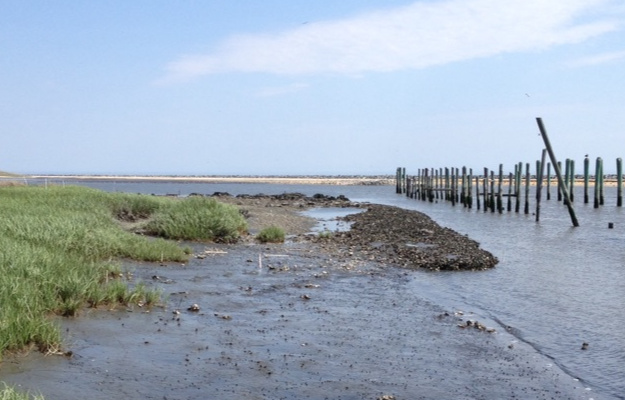
Oyster farming is sustainable, benefitting the ecosystem by replicating the environmental services once provided by great natural oyster reefs. They filter the water of the Inland Bays, which have long suffered from excess levels of nutrients and sediments that are preventing remnant seagrass beds from expanding. They provide three-dimensional structure, transforming the flat, featureless bottom typical of the Inland Bays into complex habitat that attracts a variety of important and threatened species. In this way, they serve as replacement habitat for the seagrass beds that were once ubiquitous in bays up and down the coast, and oyster farmers have been amazed at the huge variety of critters they find in and around their cages. And the aquacultured oysters help reduce the marsh erosion, important considering the high boat traffic common in the Inland Bays.
Oyster farmers take great care to keep their products safe for enjoyment by healthy consumers. As oysters filter feed, they remove not only food particles from the water, but also naturally-occurring pathogens, which are then concentrated at rates higher than the surrounding water. As a consequence, persons with certain medical conditions should never consume oysters unless thoroughly cooked, but raw oysters are nutritious and delicious for healthy persons. DNREC works with oyster farmers to enforce regulations for shellfish harvesting and handling to prevent shellfish-borne illness.
It is hoped that the new oyster aquaculture program, along with oyster restoration efforts being spearheaded by several organizations, will help restore our state waters and wetlands through the oyster’s tremendous capacity for filtering water, providing habitat, and preventing shoreline erosion. Truly, oysters are amazing environmental warriors with a keystone role in ensuring that ecosystems stay healthy for the benefit of a range of plants and animals which includes, of course, you and me!